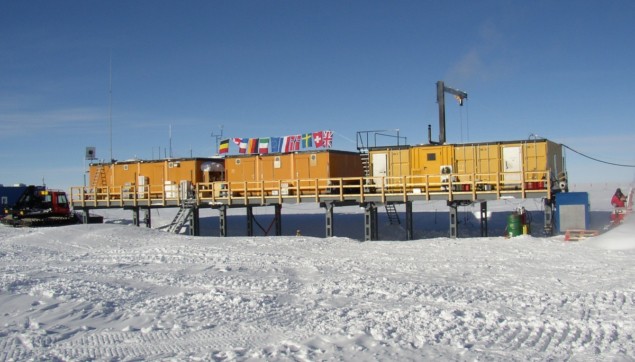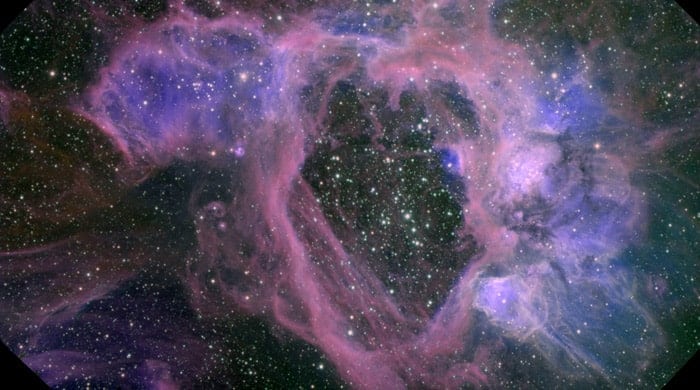
Scientists in Germany have found traces of a very rare isotope of iron within freshly fallen Antarctic snow and say that the radioactive material must have arrived on Earth in the form of interstellar dust. The finding backs up previous research revealing that iron-60 was generated by supernovae within the last few million years. But unlike those earlier observations, the iron-60 in this case has only just arrived – having reached our planet no more than 20 years ago.
In the mid-1990s, John Ellis, Brian Fields and David Schramm proposed that small quantities of iron-60 and other radioisotopes ought to be present in geological formations on Earth after being forged by exploding stars. Iron-60 has a half life of 2.6 million years, so any of it that existed when the Earth formed would have decayed long ago. But fairly recent and nearby supernovae would have provided fresh supplies, the researchers argued.
That prediction was subsequently confirmed by scientists at the Technical University of Munich (TUM), who found iron-60 within sediments beneath the ocean. Further research by that and other groups then showed the material to have been deposited 2-2.5 million years ago. The idea of a supernova origin was also bolstered after iron-60 was discovered in samples from the Moon and in cosmic rays, though experts disagreed as to when precisely the material was deposited and which specific supernovae were responsible.
Local Interstellar Cloud
In the latest work, part of the original Munich group has got together with colleagues in Germany and Austria to find out whether any of the iron-60 created in the stellar explosions continues to reach the Earth from space. Dominik Koll and colleagues reasoned that some of the radioactive isotope should be contained in dust particles within the Local Interstellar Cloud, a region of relatively dense interstellar space through which the Solar System is currently travelling at some 26 km/s. Any of those particles lying along Earth’s path should rain down on our planet’s surface as it speeds forward.
To put their idea to the test, the researchers needed material from a very uncontaminated site. TUM’s Gunther Korschinek asked a colleague if he could shovel up about half a tonne of snow near Kohnen Station, which is several hundred kilometres from the Antarctic coast. The still frozen snow was shipped to Munich and melted. A particle accelerator was then used to carry out extremely sensitive mass spectrometry to extract single iron-60 atoms from the thousands of trillions of atoms of stable iron present in a small sample. Scaling the results up, the team worked out that they had bagged about 73,000 atoms of iron-60 altogether – equivalent to just 1.2 atoms passing through each square centimetre of Antarctic snow per year.
The researchers then had to show that the iron-60 could not have had a more mundane origin. They were able to rule out a source from within the Solar System by comparing the abundance of iron-60 with that of manganese-53 and finding that the ratio was far higher than would be expected had the two types of nuclei been created by cosmic rays irradiating objects such as asteroids or comets. They also showed that the iron-60 is not related to fall-out from nuclear weapons tests, by comparing the reactions that yield iron-60 and another radioactive isotope (iron-55) for which the amount produced in weapons tests is known.
Interstellar origin
“By ruling out terrestrial and cosmogenic sources, we conclude that we have found, for the first time, recent iron-60 with interstellar origin in Antarctica,” they write in a paper published in Physical Review Letters.
Korschinek says the find is important because it provides strong evidence that at least some of the Local Interstellar Cloud must have been generated by supernovae. To make that evidence even more robust the team plans to analyse very old samples of Antarctic ice that have been dug up during the drilling of deep boreholes. The idea is to look for an abrupt rise in iron-60 concentrations when comparing ice from about 40,000-50,000 years ago with older ice – since it is believed that the Solar System entered the cloud at about that time.

Supernova sediments still rain down on Earth and the Moon
Dieter Breitschwerdt of the Technical University of Berlin, who was not involved with the research, agrees that such measurements would be interesting to carry out. He says that the Antarctic results “give new impulses to nuclear astrophysics research” and “strong support” to the idea that supernovae were responsible for the iron-60.
According to Jeffrey Linsky at JILA in Boulder, Colorado, the local cloud may have formed after a supernova shock wave compressed and ionized the gas in the interstellar medium. As such, he says, iron-60 atoms could be concentrated at the edge of the cloud. He adds that any future change in the rate of deposition of iron-60 in the Antarctic might indicate that the Earth is crossing this boundary. “The timescale for the Sun leaving the local cloud is less than about 3000 years,” he says, “but it could be only a few years”
John Ellis says that the Antarctic measurements also help to establish the background level of iron-60 injected into the interstellar medium by supernovae spread out in time, with the latest results constraining the type and number of supernovae involved. “The picture so far is incomplete because there are relatively few data,” he says. “This result is important because it gives us new kinds of data to work out the origin for the iron-60.”
- The full results are published in Physical Review Letters.



